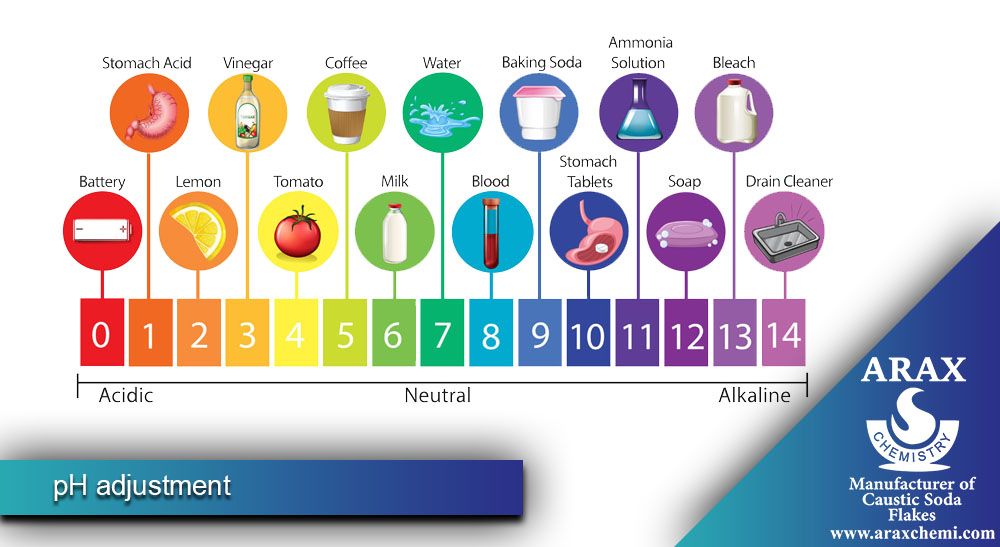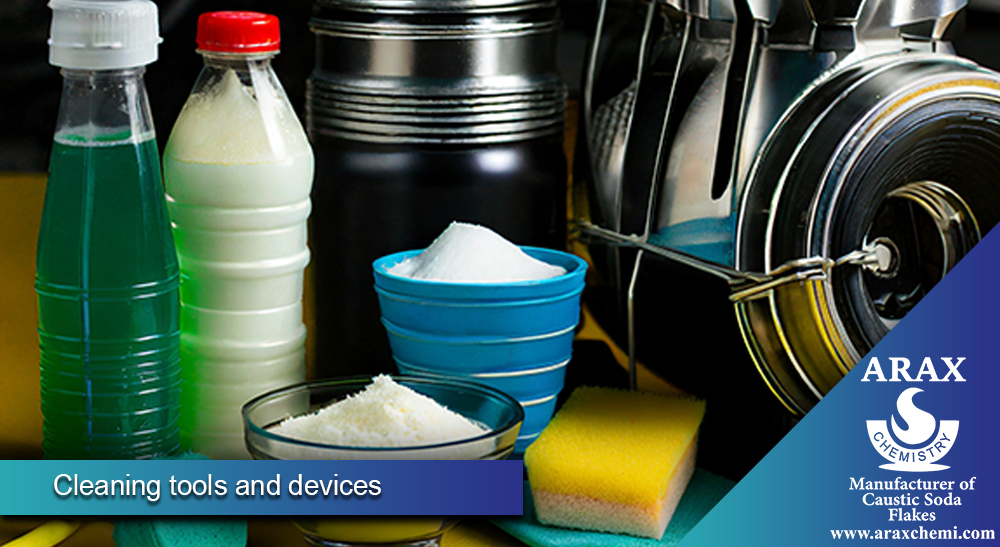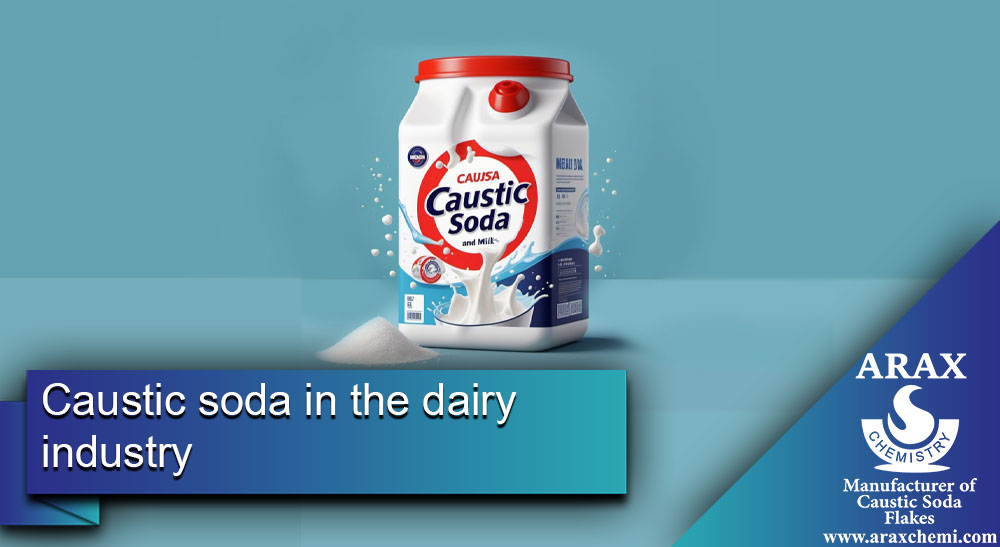Caustic soda in the dairy industry
Caustic soda (NaOH) is one of the basic chemicals that has wide applications in many industries, including the dairy industry. This chemical compound has strong alkaline properties and is known as an efficient chemical in the dairy industry. Applications of caustic soda in the dairy industry include adjusting pH, accelerating the fermentation process, and cleaning and disinfecting equipment. In this article, we will examine the benefits and applications of caustic soda in the dairy industry.
What is the dairy industry?
Dairy industry is a set of activities and industries that are engaged in the production, processing and distribution of products related to milk and its derivatives. This industry mainly focuses on milk base and production of products like fresh milk, cheese, yogurt, butter, buttermilk, ice cream and other dairy products. The dairy industry is the most important part of the food industry of any country and plays an important role in meeting the food needs of humans at the global level.

Dairy producers usually procure milk from farmers, then the milk is transported to factories or processing units, where various types of dairy products are produced. In milk processing, processes such as pasteurization, purification, aggregation, cheese production, yogurt production and other products are performed. Then the dairy products are packaged and marketed.
Caustic soda in the dairy industry
Caustic soda is one of the most important chemicals that has wide applications in various industries, including dairy industries. In the following, we discuss some of the uses of caustic soda in the dairy industry.
- pH adjustment: due to its alkaline properties, caustic soda can be used in dairy production processes such as cheese, yogurt and other dairy products, adjusting the pH of the environment to reach suitable conditions for biological interactions and production of final products.
- Disinfection of tools and devices: Caustic soda is used as a strong cleaner in the dairy industry. This material is able to remove oils, fats and proteins found in equipment and industrial surfaces. Also, the antibacterial property of caustic soda can be useful in controlling the growth of microorganisms and maintaining the health and quality of dairy products.
It should be noted that caustic soda in the dairy industry must be used carefully and in accordance with the appropriate amounts and conditions, because this substance has strong alkaline properties and if used incorrectly, it can harm food and people’s health. Correctly following the instructions and using exact amounts of caustic soda in dairy processes guarantees the quality of the products.
pH adjustment in the dairy industry
In the dairy industry, pH adjustment is used as an important factor in the production of products. Adjusting pH means controlling and determining the level of acidity or alkalinity of products. The pH of the product is determined based on the amount of hydrogen ions (H+) in the solution and is expressed as a numerical scale from 0 to 14. A number less than 7 means acidic, a number 7 means neutral, and a number greater than 7 means the product is alkaline. In the rest of this article, we will discuss some features of pH adjustment.

- Preservation property: proper pH adjustment can help the shelf life and stability of the product. By adjusting the pH in the appropriate range, the growth of unwanted microorganisms such as bacteria and fungi is inhibited and premature spoilage of the product is prevented.
- Sensory characteristics: adjusting the pH can improve the taste, aroma and consistency of the product. Each dairy product usually has a specific pH that is required to obtain its desired sensory characteristics. For example, for the production of yogurt, the pH must be in the range of 4 to 4.6 in order to produce the desired flavor and consistency of yogurt.
- Interaction with other substances: The interaction of substances in dairy products is affected by pH. For example, in cheese production, pH adjustment can regulate the deacidification process, the accumulation of casein (a substance that plays a major role in the formation of cheese structure) and cheese sediments.
The microorganisms used in the fermentation process also play an important role in the final characteristics of the product. For example, the use of specific bacteria can help produce products with specific flavors and textures. Also, some bacteria can help produce health-promoting agents such as probiotics.
By using pH adjustment in the fermentation process, dairy products with desirable characteristics can be produced and a significant improvement in the sensory properties, stability and storage of these products can be achieved.
Fermentation process
By using caustic soda in the fermentation process of dairy products, the speed and quality of fermentation can be improved. In the following, I will explain more about this process and how to use caustic soda.

- The importance of fermentation in the dairy industry:
Fermentation is one of the basic processes in the dairy industry, which takes place using beneficial microbial bacteria, such as Lactobacillus and Streptococcus. In this process, bacteria convert the sugar in the milk into lactic acid, which creates the specific taste, texture and properties of dairy products.
- Using caustic soda in fermentation:
The use of caustic soda is very effective in the fermentation process of dairy products. By increasing the pH of milk, caustic soda can increase the rate of fermentation. For optimal fermentation, the pH of the milk must be in a suitable range, and by using caustic soda, the pH can be precisely adjusted and the fermentation process can be improved.
- How to use caustic soda:
To use caustic soda in the fermentation process, it is necessary to prepare a caustic soda solution with a suitable concentration. Then, the solution is continuously added to the milk to adjust the pH of the environment for fermentation. Of course, the amount of caustic soda should be used carefully and according to the type of product. Keep in mind that the use of caustic soda must be done correctly and the amount of use must be carefully determined according to the type of product, the desired formulation and the instructions for producing the product. Also, the manufacturer’s guidance and recommendations and health standards should be followed.
Disinfection of tools and devices
Caustic soda (sodium hydroxide) is used to clean dairy tools and equipment, but should be done with caution and following safety guidelines. In the following, I will explain more about the use of caustic soda to disinfect tools and equipment in the dairy industry:

- Cleaning tools:
Caustic soda, as a chemical substance with strong alkaline properties, can be used to clean tools. Equipment such as funnels, dough mixers, dairy production pipes and tanks, and special containers can be cleaned using caustic soda. In this process, caustic soda is mixed with water and the surface of the tools is coated with baking soda. Then, using a suitable brush or sponge, the surface of the tools is cleaned. After the cleaning operation is completed, the tools should be thoroughly washed with water and free from any traces of caustic soda.
- Cleaning dairy products machines:
In some cases, caustic soda can be used to clean some dairy products machines. For example, caustic soda can be used to clean molds and trays used in cheese production. For this purpose, caustic soda is mixed with water and the surface of molds and trays is smeared with caustic soda. Then, using a suitable brush or sponge, their surface is cleaned. After the cleaning operation is completed, the products should be thoroughly washed with water and free from any presence of caustic soda.
Caustic soda is used in which dairy foods?
Caustic soda is used in some dairy foods, but should not be used directly in all dairy products. We will discuss some of them in this article.
- Cheese: In the production of some types of cheese, such as pizza cheese and mozzarella cheese, caustic soda may be used as a pH adjusting agent.
- Qarqorut: In some methods of preparing qarqorut, caustic soda may be used to adjust the pH and increase the fermentation speed.
- Fermented milks: In some dairy drinks such as fermented milks, caustic soda may be used to adjust the pH and accelerate the fermentation process.
In general, caustic soda is only used to adjust the pH and increase the fermentation speed.
Does the use of caustic soda in the fermentation of dairy products have an effect on the color and taste of the product?
The use of caustic soda in the fermentation of dairy products may affect the color and taste of the product. Of course, these effects depend on the amount and concentration of caustic soda used, the type of product and the process conditions. Below are some of the effects of caustic soda on dairy products:

- Product color:
The use of caustic soda can affect the color of the product. By increasing the pH of the milk with caustic soda, the color of the product may change. For example, in some dairy products such as yogurt or buttermilk, white and light color is preferred. The increase in pH destroys the natural pigments in milk, which may be yellow or cream, and changes the color of the product. Therefore, the use of caustic soda should be done strictly according to the type of product and the color standards associated with it.
- Product taste:
The use of caustic soda can affect the taste of the product. As the pH of milk increases, the production of lactic acid by fermentative bacteria increases. This produced lactic acid can change and improve the taste of the product. Also, the concentration and composition of caustic soda can have an effect on the taste of the product. Therefore, the use of caustic soda should be done carefully according to the type of product and the associated taste standards.
In any case, for the correct use of caustic soda in the fermentation of dairy products and maintaining the desired color and taste, you can refer to the manufacturer’s guidance and recommendations and health standards. Yes, the use of caustic soda in the fermentation of dairy products may affect the color and taste of the product. Of course, these effects depend on the amount and concentration of caustic soda used, the type of product and the process conditions.
Advantages and disadvantages of using caustic soda in dairy industries
The use of caustic soda in the dairy industry can have certain advantages and disadvantages. Below are some of the possible advantages and disadvantages:
Benefit
- Improving the fermentation speed: Using caustic soda can increase the fermentation speed in the dairy industry. By adjusting the pH of the environment to a suitable value, the fermentation process is improved and the time required for product production is reduced.
- pH adjustment for the production of specific products: by using caustic soda, the pH of the environment can be precisely adjusted. This makes it possible to provide suitable conditions for the production of certain products that require a certain pH.
Defect
- Effect on color and taste: The use of caustic soda can have an effect on the color and taste of the product. An increase in pH can change the color and taste of the product, and in some cases, it may cause the loss of natural pigments in milk.
- The need for accuracy in the amount of use: improper use of caustic soda may cause unwanted changes in the color, taste and structure of the product. Therefore, the need for accuracy in the amount and concentration of caustic soda usage, as well as compliance with the manufacturer’s guidelines and health standards is a must.
- Impact on the production process: the use of caustic soda may require changes in the production process and device settings. This requires more time and money.
Summary
In this article, the benefits and applications of caustic soda in the dairy industry were investigated. The use of caustic soda in the dairy industry as a strong alkaline substance provides the ability to adjust the pH of environments, accelerate the fermentation process, and provide cleaning and disinfection. Precise pH adjustment is critical in the production processes of dairy products, and caustic soda allows us to do this. Also, the use of caustic soda in the fermentation process can increase the rate of fermentation and lactic acid production, which improves the quality and shelf life of dairy products. Also, sodium hydroxide as a strong detergent can clean the surface of dairy industrial equipment and devices and reduce possible bacteria and microorganisms. As a result, caustic soda, as an efficient and multipurpose chemical, is of special importance in the dairy industry and can help improve the performance and quality of dairy products.

